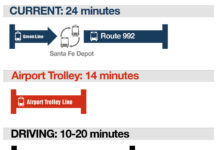Third consecutive month of big savings aided by rainstorm that reduced irrigation
Urban potable water use in San Diego County fell by approximately 32 percent in July 2015 compared to July 2013, according to preliminary numbers released today by the San Diego County Water Authority. That follows a decrease of 26 percent in June compared to June 2013 and a 30 percent decline in May.
July was the second month in which the State Water Resources Control Board required compliance with conservation targets set for each local water agency. State-mandated targets for Water Authority member agencies are between 12 and 36 percent below 2013 levels; the countywide average target is 20 percent.
Record rainfall from a tropical storm in July gave a boost to water-saving efforts already under way across the region as residents and businesses complied with state mandates not to irrigate during rainstorms or for 48 hours after receiving measurable rain. The net result was the lowest July water use for the region since at least 1975.
“We’re off to a great start with water savings since state water-use targets took effect, and that’s a credit to everyone across our region,” said Mark Weston, chair of the Water Authority’s Board of Directors. “It will be challenging to keep up the pace if high temperatures stick around for the next couple months, but I’m convinced that we can do it because of all the conservation efforts I’m seeing at homes and businesses.”
Conserved water in San Diego County can remain in storage for future use, a valuable asset should drought conditions continue into 2016 or beyond.
As a wholesale water agency, the Water Authority coordinates drought response actions for the region. The regional drought response strategy centers on decreasing ornamental landscape irrigation first to minimize the economic disruption caused by cuts to water used by industrial, commercial and farming operations. In May, the Water Authority’s Board adopted a set of measures to help local water agencies meet the state’s water-use reduction targets. It included immediately boosting regional conservation and outreach efforts and restricting irrigation of ornamental landscapes with potable water to no more than two days a week across the region. Member agencies have the flexibility to set their own watering days and times.
For information about water-use rules by community, along with details about drought conditions and conservation-related resources, go to www.whenindrought.org.




